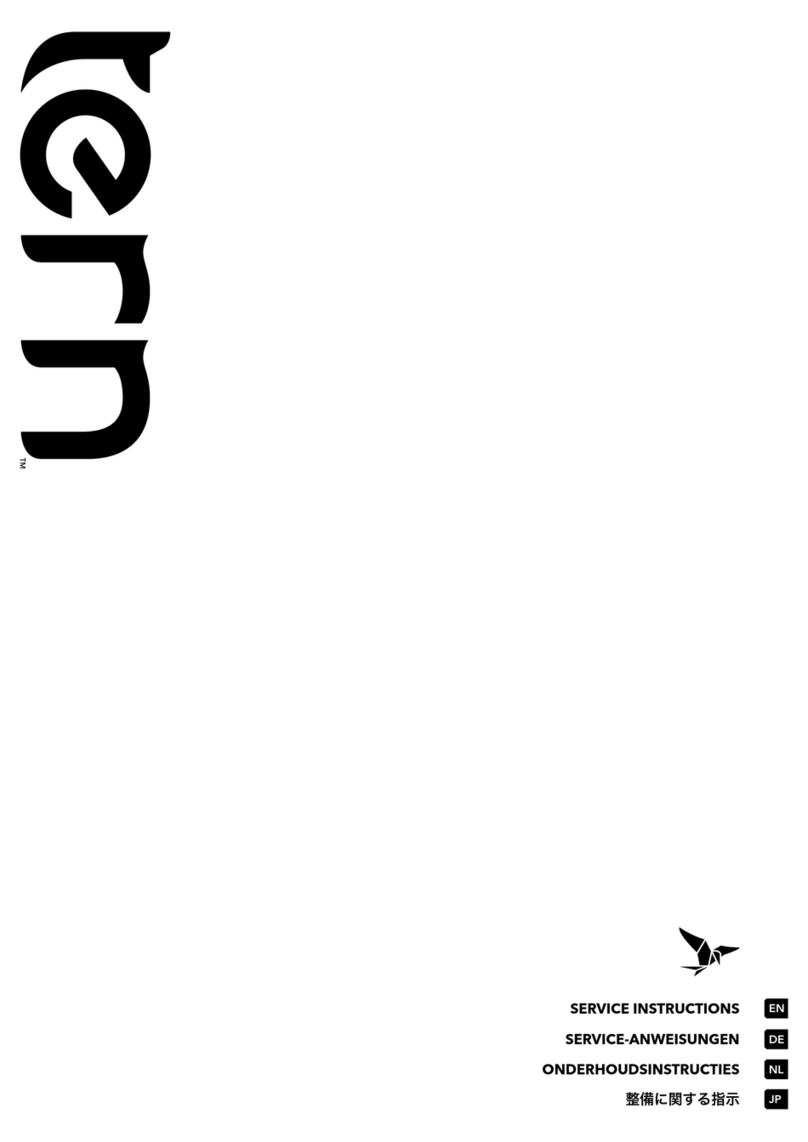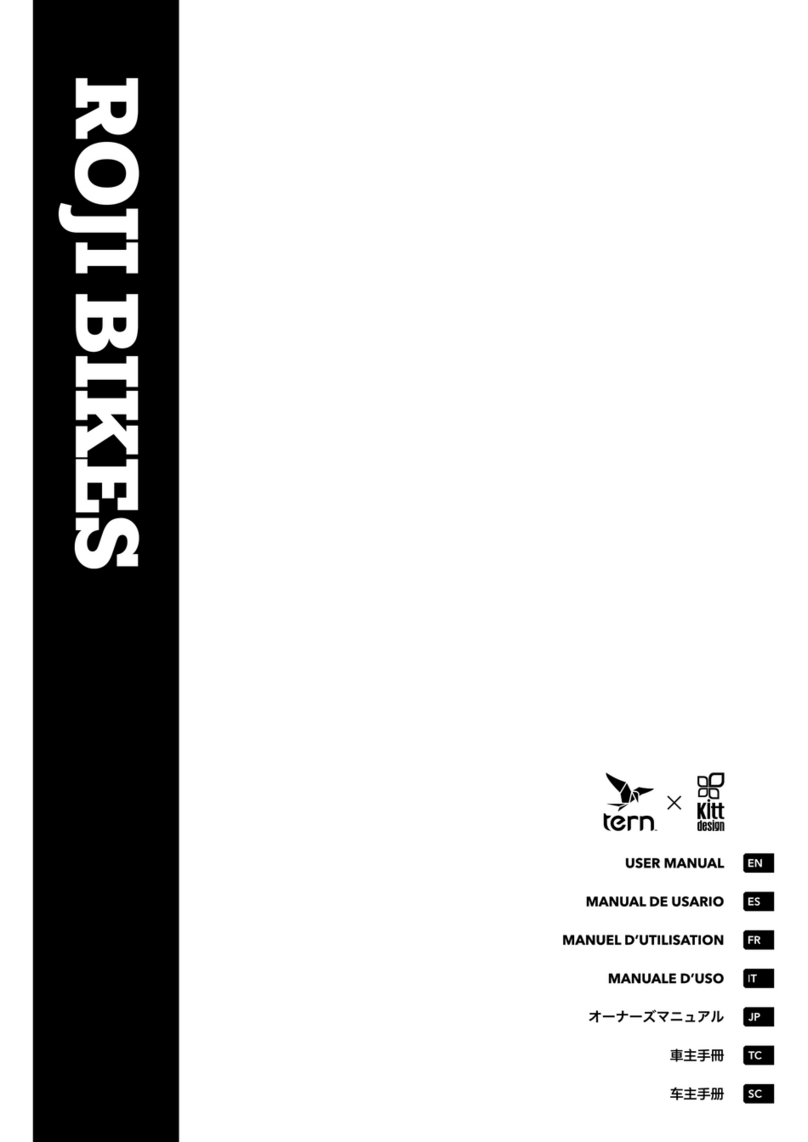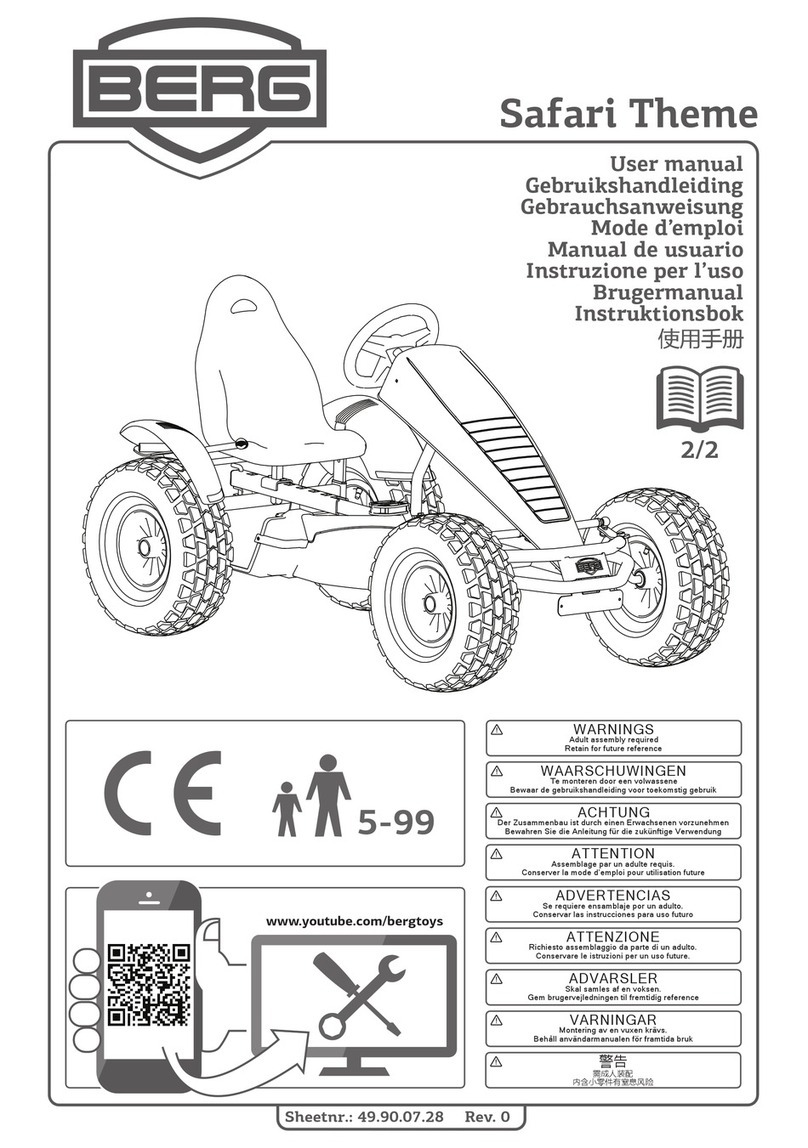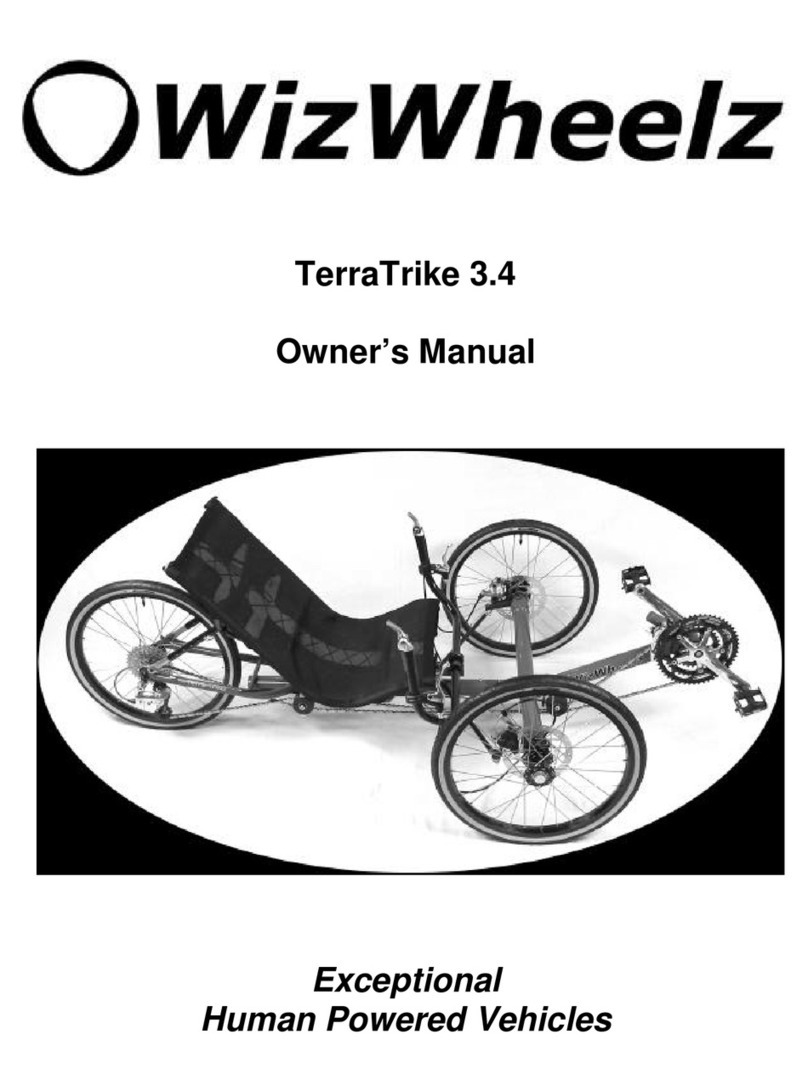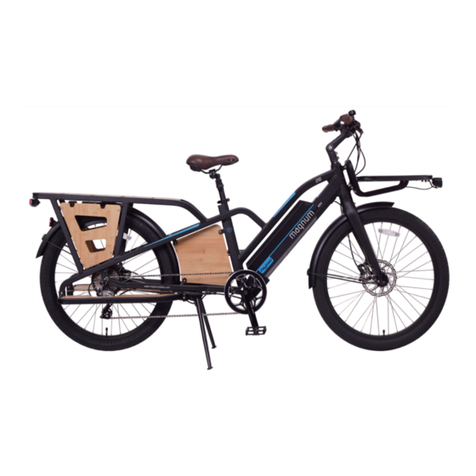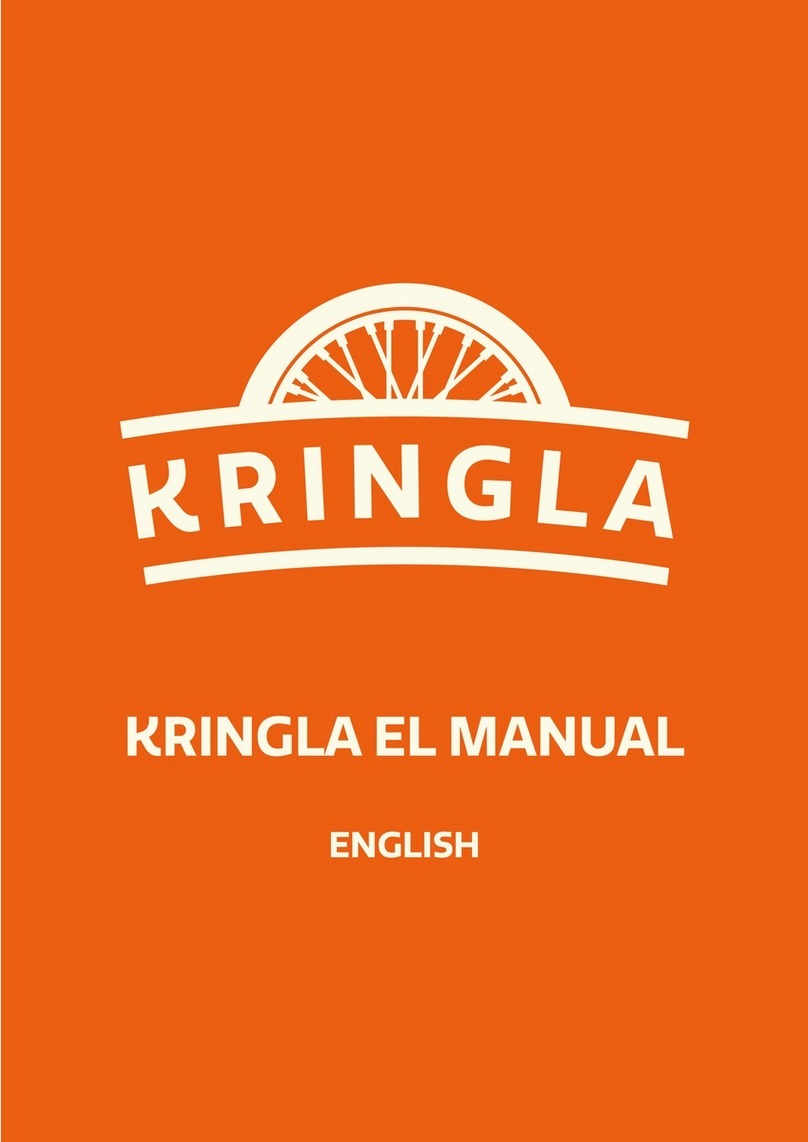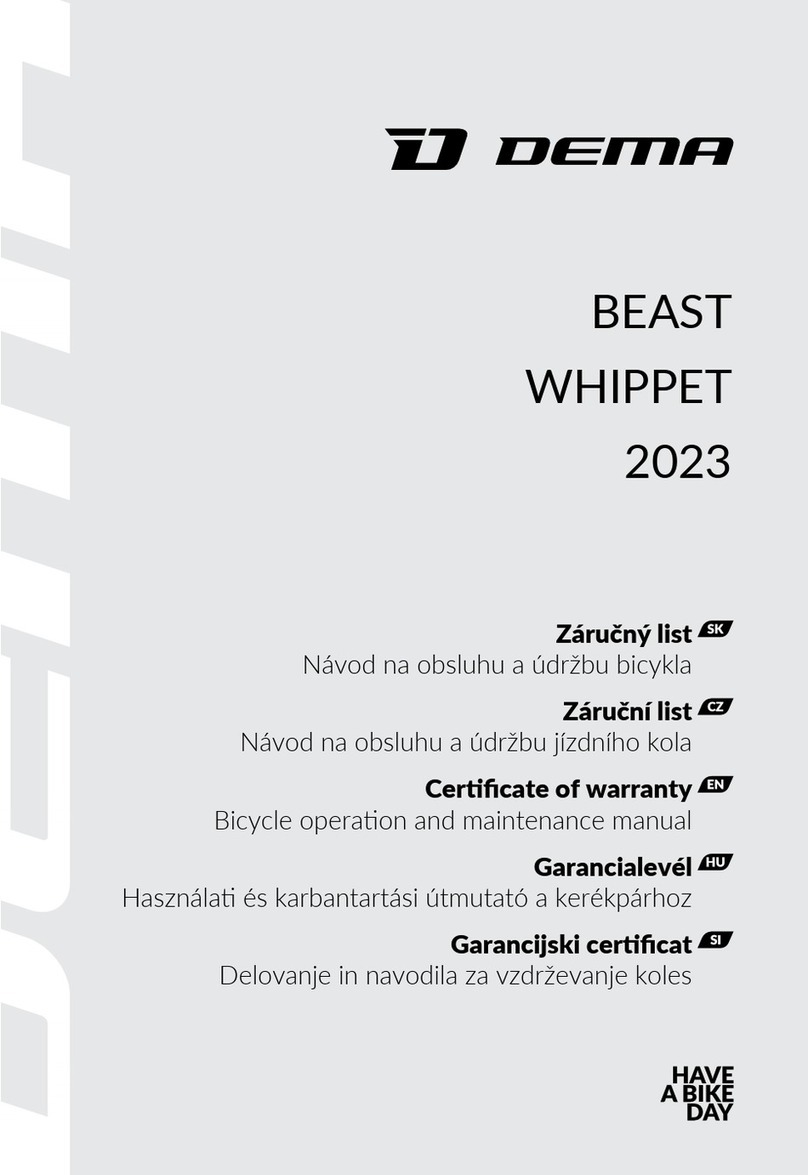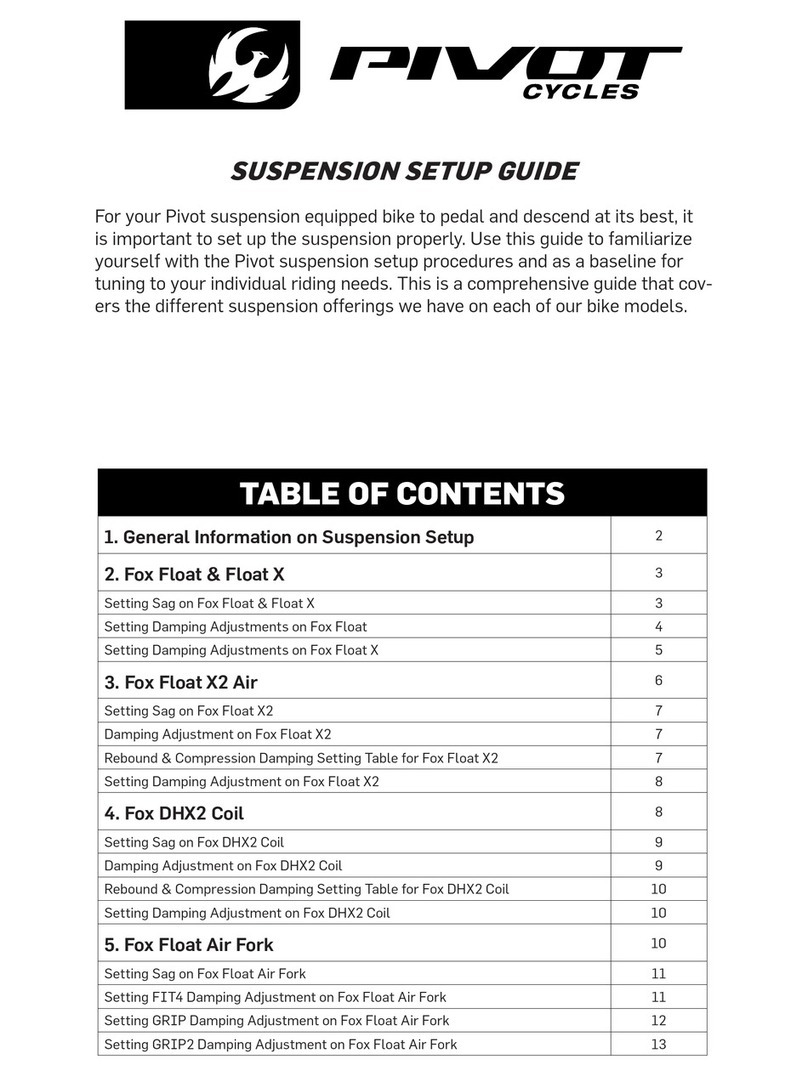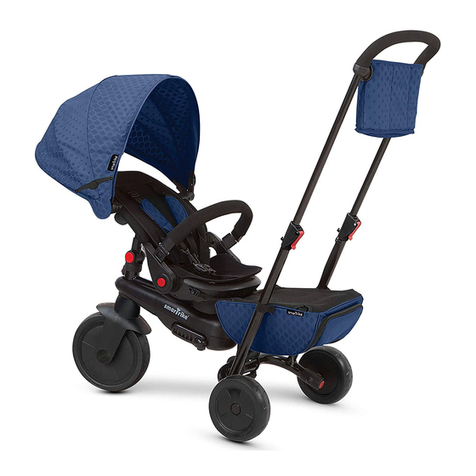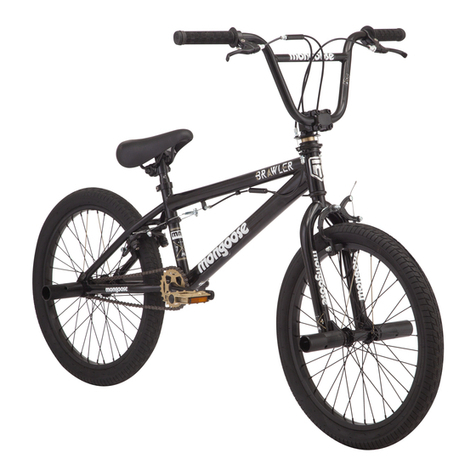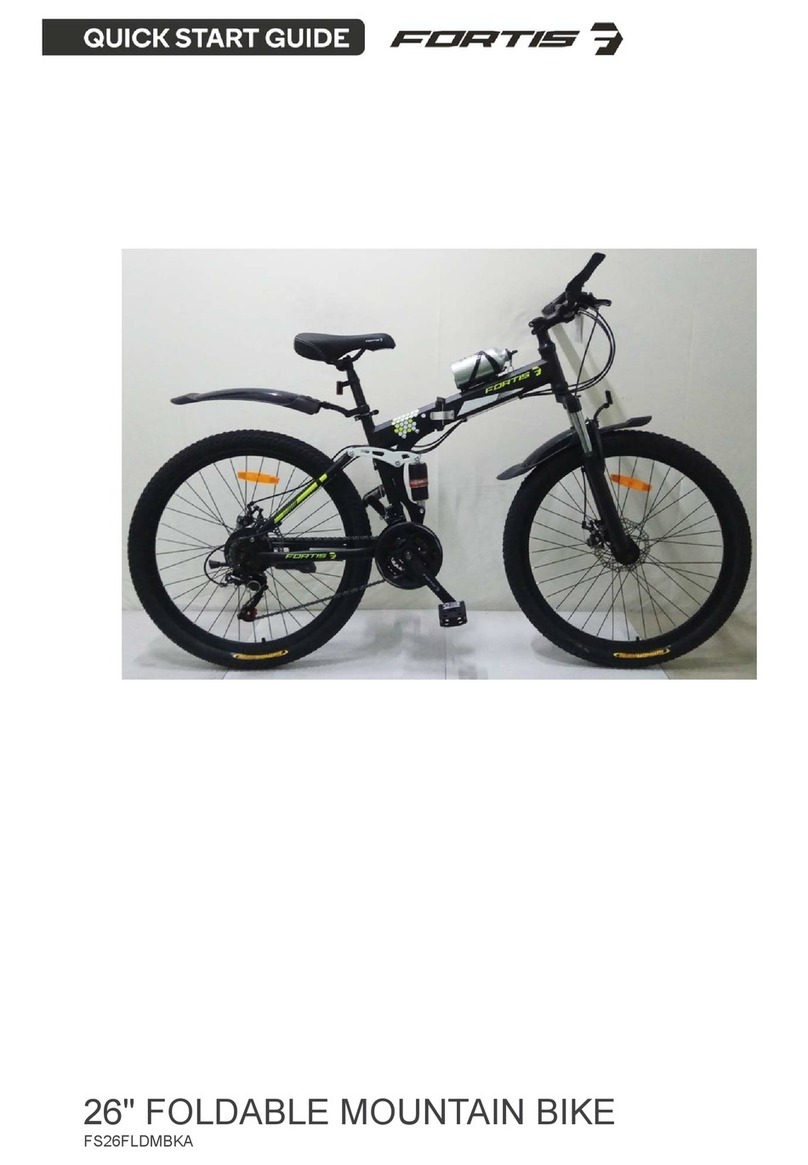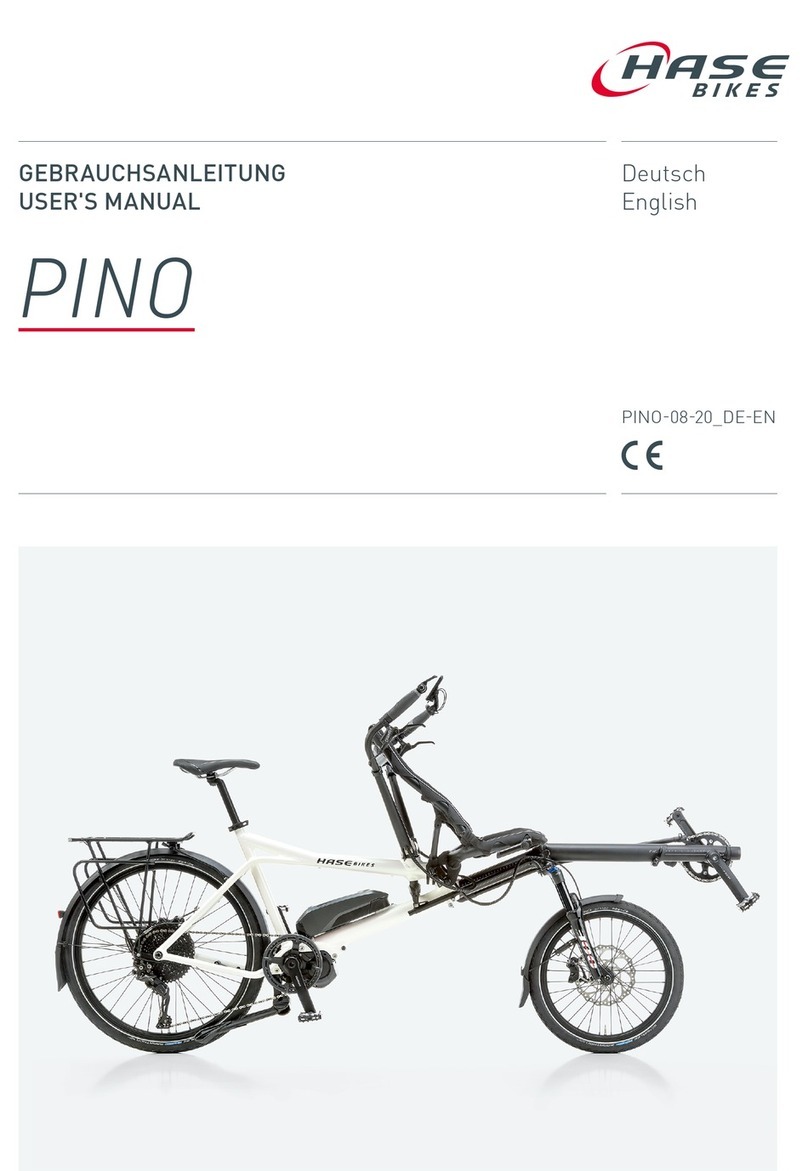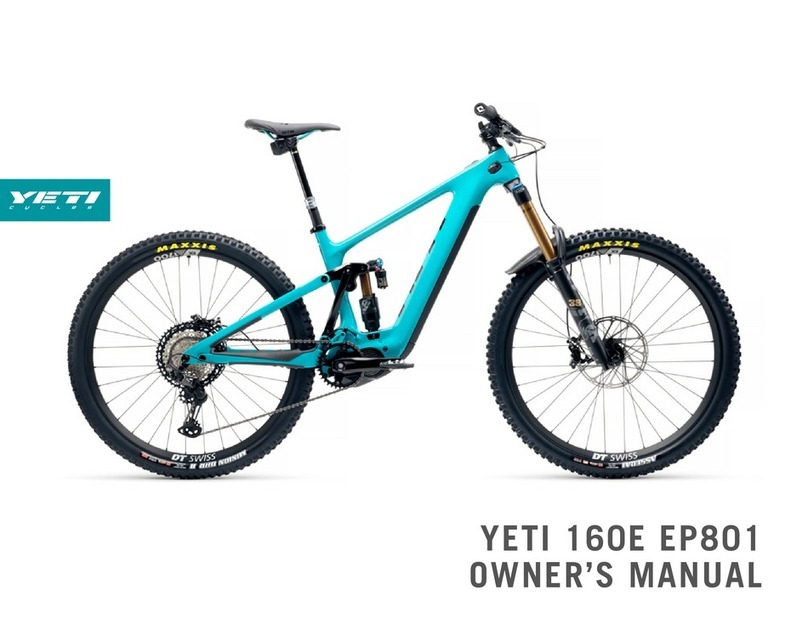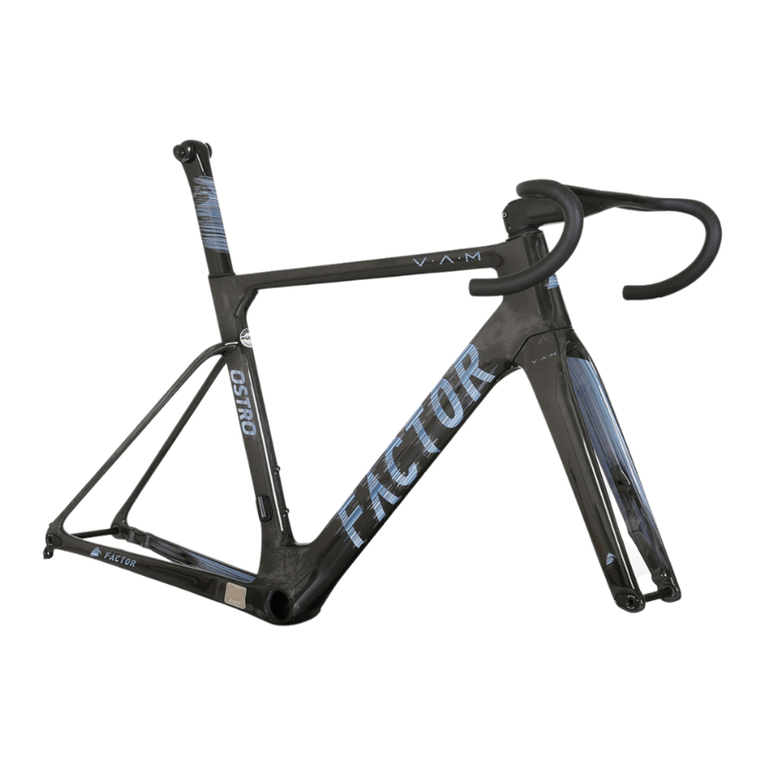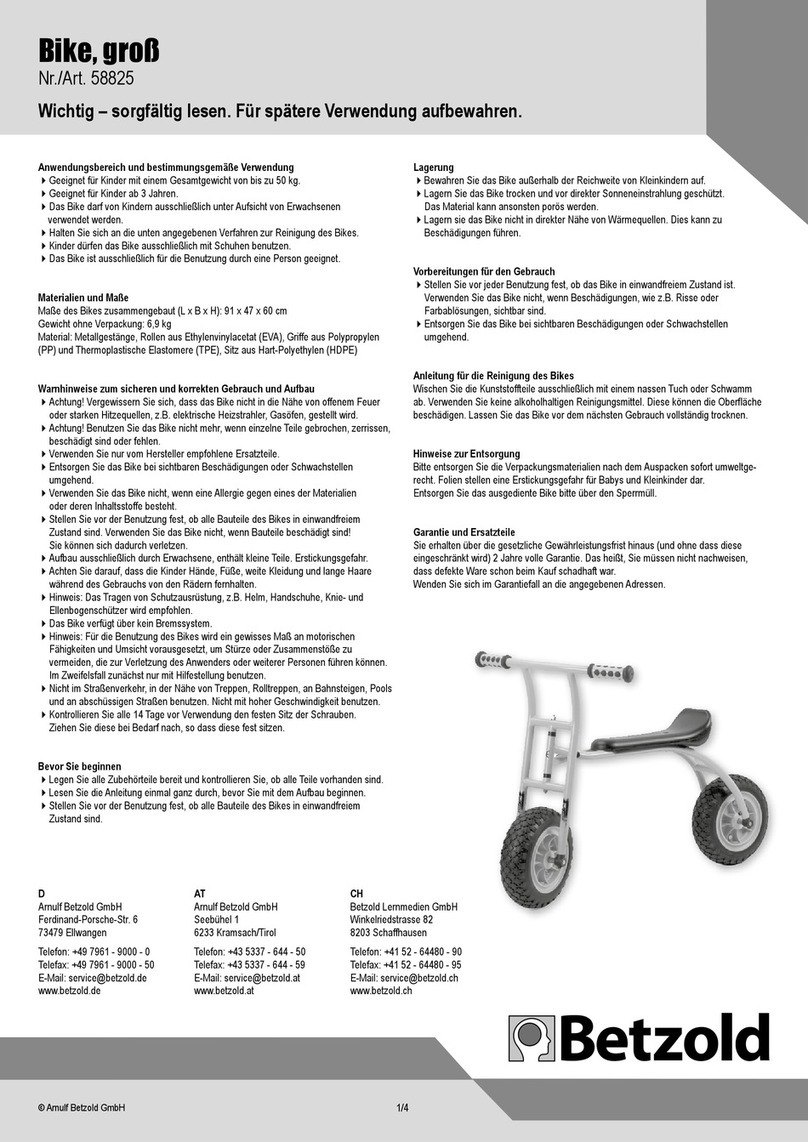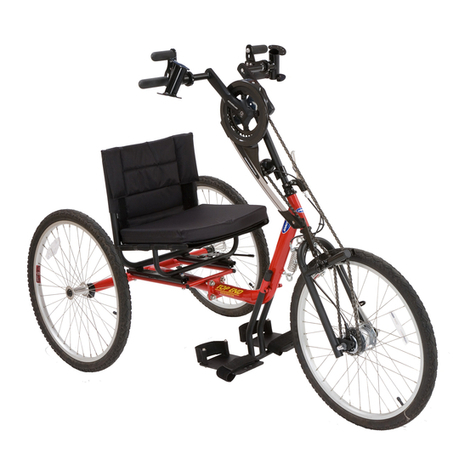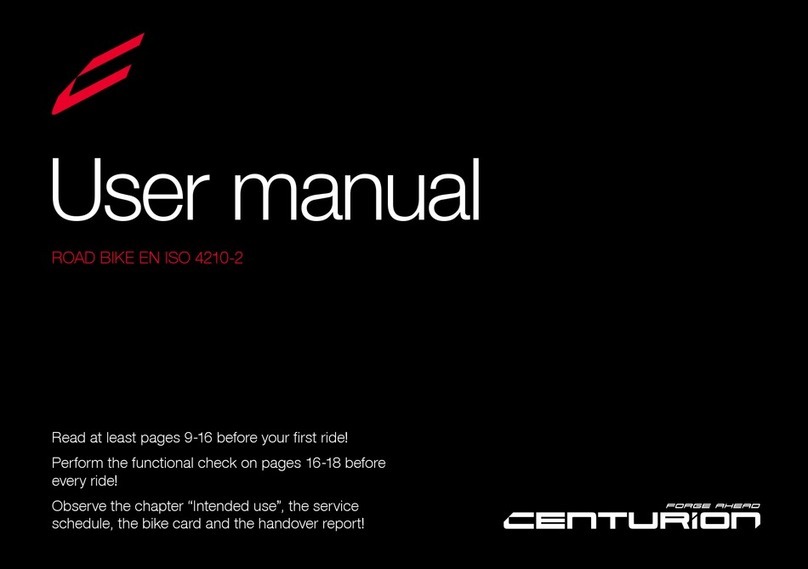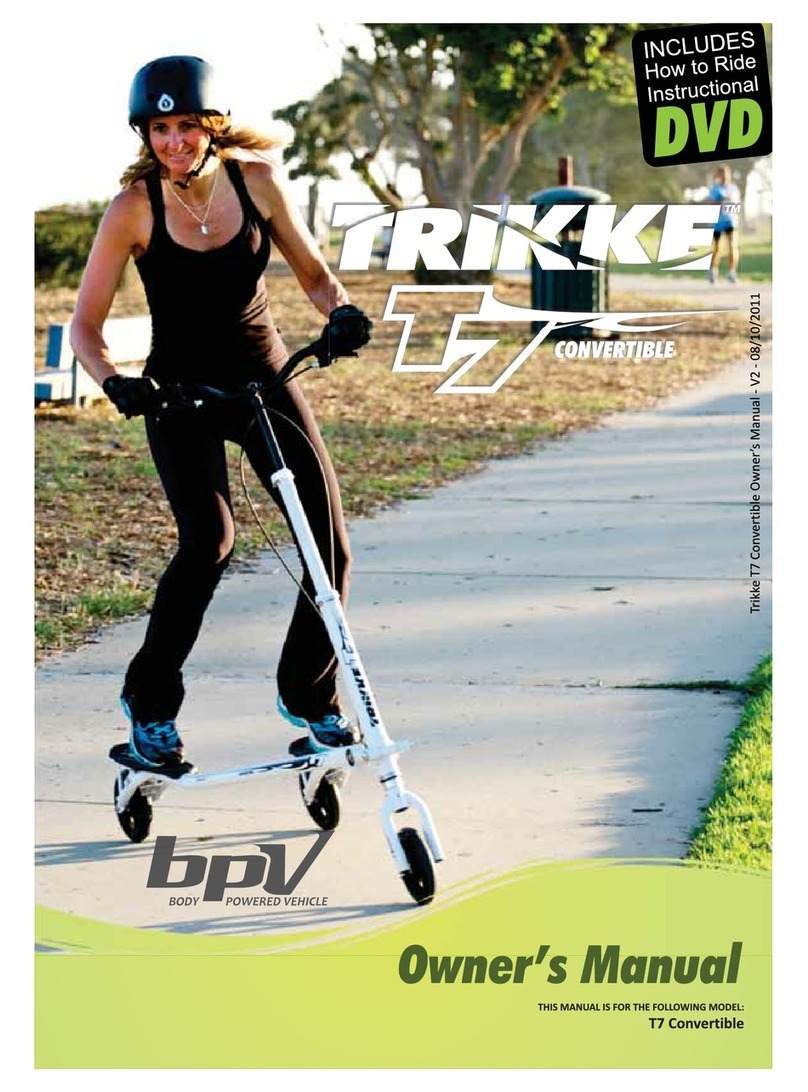Tern PEDELEC User manual

EN
FR
USER MANUAL E-BIKE (PEDELEC)
Original Instructions
MANUEL D’UTILISATEUR VAE (PEDELEC)
Traduction des Instructions Orginales

EN
2
1. Introduction…………..................................
2. General Information………………............
3. Legal Details …………...............................
4. Local Regulations ………….......................
5. Intended Use …………...............................
6. Unfolding and Folding your Tern …….....
7. Before the First Ride…………...................
8. Before Every Ride ………….......................
9. Safe Riding …………..................................
10. Luggage and Children Transport …….....
11. Transporting your Tern …………...............
12. ABCs of Pedelec ………….........................
13. Tips for Riding a Pedelec …………............
14. Service …………..........................................
15. Torque Settings …………...........................
16. Service and Maintenance Schedule ……
Contents
17. Warranty …………............................... 35
18. Declaration of Conformity …………. 38
3
4
5
5
7
7
8
13
16
18
20
21
23
26
30
32

EN
3
Dear Customer,
Thank you for choosing Tern, a leader in urban mobility and transportation!
We design bikes that bring together all the things people need to drive less and ride more.
We are dedicated to the goal of sustainable transportation, and design and manufacture bicycles for urban transport with a focus on
portability and utility. Tern donates at least 1% of net profits every year to social and environmental causes.
General Safety Notes
Turn the page
Your bicycle has specially designed components so please read this manual carefully before riding. Before hitting the road, spend some
time to understand how to operate your new bicycle in a safe environment such as a parking lot.
Respect others on the road
Please obey traffic laws and respect motor vehicles. You and your bike will always lose in a vehicle collision and you can also injure
pedestrians. Stay alert and show consideration to other road users.
Head protection
A good, authorized bike helmet may prevent injury in an accident. Wear one, it’s a no-brainer.
Servicing precautions
Do not proceed with servicing or adjustments without proper knowledge or tools.
Hit the books
This manual is only to be used in conjunction with other manuals included with your pedelec such as motor, control system, component,
and folding manuals.
Where to Go for Additional Help
If you are unsure about anything, please talk to your local Tern dealer. Tern dealers are specialists in Tern products and servicing.
1. Introduction

EN
4
Bike Parts
Meaning of Icons
1. Wheel
2. Cassette
3. Rear Derailleur
4. Chain/Belt
5. Chainring
6. Motor
7. Crankset
8. Pedal
9. Brakes
10. Fork
11. Carrier/Rack
12. CE Frame Sticker
13. Battery
14. Battery Lock
15. Seat Post
16. Saddle
17. Frame Joint
18. Frame
19. Handlepost Joint
20. Handlebar
21. Handlepost
22. Headset
3
1
2
5
4
Handlebar
1. Controller/Display
2. Light
3. Handlebar
4. Brake Lever
5. Shifter
Indicates how to use the
product or items that
require special attention.
Incorrect action could
result in damage to the
equipment.
Life-threatening danger if
instructions are not
followed or preventive
measures are not taken.
You must have the proper tool, such
as a torque wrench for items that
require a specific torque. A torque
that is too high or too low can cause
parts to fall off or break and can lead
to serious accidents and injuries.
1
3
47
8
15
16
18
17 21
19
20
22
10
13
6
11
5
2
14
9
12
2. General Information

EN
5
Manufacturer
Mobility Holdings Limited (Hong Kong), Taiwan Branch
8F-8, Lane 609, Chongxin Road, Section 5, Sanchong District, New Taipei City, Taiwan
Marking on Bike
If your Tern is a pedelec, it will have a CE frame sticker which confirms that it has passed all tests outlined in EN 15194.
Declaration of Conformity
This user manual complies with the requirements of EN 15194 and Machinery Directive EC/2006/42.
See the separate Declaration of Conformity insert.
Edition 1 Rev 0, December 2016
Pedelec stands for pedal electrical cycles. They are also known as EPACs which stands for Electrically Power Assisted Cycles. Pedelecs are
bicycles with a motor that provides assistance when a rider starts to pedal. When a rider stops pedaling, the assistance stops. Some bikes
will also have a push assistance mode with a max speed of 6 km/hr.
In general, electric bikes are viewed by law as more similar to a conventional bicycle than a motorized scooter or motorcycle. In most
cases, an electric bike can be ridden in bike lanes, on bike paths, and can be locked to bike racks like a regular bicycle. Riders are not
required to have a driver’s license to operate an electric bike and are not required to obtain any special licensing or registration for their
pedelecs.
It’s important to note that the specific laws, rules, and guidelines governing electric bike use may vary from country to country.
If you are not using your bicycle in Germany, it’s important to familiarize yourself with the laws in your specific location before
you begin riding your pedelec. Take time to learn local bike laws before hitting the road.
To use public roads with your pedelec in Germany, your bike must be equipped in accordance with Road Licensing Regulations (StVZO)
and the Road Traffic Act (StVO). Please note there may be different regulations that apply in your country.
3. Legal Details
4. Local Regulations

EN
6
StVZO
The lighting system needs to have the K-number mark to be legal on public roads. The front and rear lights must be powered by the
same power source.
The front light projection center must be no more than 10 meters from the front of the bike on the road. The rear light must be mounted
at least 25 cm above the road surface.
Reflectors are required, in addition, to lights. In the front, a white reflector is required. In the rear, at least two red reflectors are required.
Two yellow reflectors must be attached to each pedal.
Each wheel must meet at least one of the below requirements:
Two yellow reflectors
White reflective rings on both sidewalls of the tires
The braking system must have independent functioning front and rear brakes.
You must maintain the bike in good condition.
10 m

EN
7
Built for Urban Warriors, not Stuntmen
Watch the Weight
Tern bicycles are only designed for one person riding with both wheels in contact with the ground on paved roads only. They
are not intended for racing, jumps, hops, wheelies or anything of the kind. The manufacturer and dealer are not liable for any
direct or consequential damages. The warranty will be void if your pedelec is not used in accordance with the intended usage.
Using the bike for off-road riding, jumps or stunts may cause damage to the frame and risk injury or death to the rider.
Maximum carrying capacity = Rider weight + Cargo weight
The maximum carrying capacity of your Tern Pedelec is 105 kg (230 lbs)
If the maximum weight stated and your bike’s CE Frame Sticker differs, follow
the CE frame Sticker.
If carrying cargo or extra weight, make sure the bike is stable and is within the
maximum load capacity.
Practice handling the bike in a safe area before riding on public roads.
If not properly handled, sudden shifts in load while riding can affect your balance and lead to serious injury or death.
Please see the separate enclosed folding instructions.
5. Intended Use
6. Unfolding and Folding your Tern
CE Frame Sticker example

EN
8
Hit the Books before You Ride
Spend some time to understand how to operate and use your new bike before hitting the road. Operating manuals for individual
components and folding instructions for your specific bike are supplied together with this manual. Please read all the manuals.
If anything is unclear, ask your dealer.
Please Check
Electrical system
Make sure you are familiar with the function of all the controller buttons and meaning of the displays.
Please consult the information in the relevant section from the manual of the motorized system manufacturer.
Wheels
Check the Tire pressure and make sure it is within the minimum and maximum values indicated on the sidewalls of the Tires.
Spin both Wheels to make sure they rotate smoothly, are true (not wobbling) and do not rub against the Brakes. If the Wheel wobbles
side to side or rubs against the Brake Pads, take the bike to a qualified bike shop to have the Wheel trued or replaced.
Wheels that do not run true may indicate problems with the Spokes or Tires.
Headset
Stand with the Front Wheel pressed firmly between your legs and try to twist
the Handlebar. If movement occurs, realign your Handlebar and tighten the
Headset and handpost base or service it at your dealer.
Lift the Front Wheel off the ground and swing it from side to side. Does it feel
smooth? If you feel any binding or roughness in the steering, you may have an
overly tight Headset. Have your dealer check it.
7. Before the First Ride
Do the twist

EN
9
Brakes
CBA
3
4
2
1
Test your Brakes by standing next to your bike, pull both Brakes, and rock the Bike back and forth. (A) The Bike should not roll and the
Brake Pads should remain firmly in place.
Does your Tern feel solid? If you feel a clunk with each forward or backward movement of the bike, you probably have a loose
Headset. Have your dealer check it. Note that for certain Disc Brakes you may feel a bit of play when attempting to rock the bike back
and forth. These are caused by the built-in clearances between the Brake Pads and the Brake Caliper to allow for thermal expansion and
is considered normal. In these cases, it’s not a loose Headset.
Rim-Actuated Brakes (B) have Brake Pads (1) that align with the Rim (2). The Brake Pads press against the Rim to slow the Wheel so
make sure the Brake Pads align with the Rim. Check Rim and Pads for wear.
Disc Brakes (C) have a Disc Rotor (3) and a Disc Caliper (4). Pads inside the Disc Caliper squeeze the Disc Rotor to slow the Wheel but
can get very hot under use. Do not touch them immediately after riding.
Which Lever operates the Front Brake and which Lever operates the Rear Brake varies depending on the country. For countries such as
United Kingdom and Japan, the left lever operates the rear brake and the right lever operates the front brake. For USA, Germany and
most other countries the right lever operates the rear brake and the left lever operates the front brake.
Be careful not to damage the Disc Rotor or Disc Caliper when changing wheels or by pulling the Brake Levers when the Disc
Rotor is not aligned.
Make sure to test the braking power before heading into traffic. It can be much more powerful than what you are used to.
Squeezing the Lever too fast can lead to unintended sudden stopping and cause you to crash or get rear ended.

EN
10
Gears
Test ride in a safe area away from traffic to familiarize yourself with the function of the Gear Shifters and how to upshift and downshift.
Check that indexing (shifting from gear to gear) is crisp and that you are able to shift into the lowest and highest gears without the
Chain skipping.
If your Tern uses an Internal Gear Hub (IGH), avoid shifting and pedaling hard at the same time. Unlike derailleurs, most conventional
IGH’s are designed in such a way that it shifts optimally when coasting or not pedaling / coasting / stationary. This mean Internal Gear
Hubs can shift when you are stopped, a very nice feature in stop-and-go urban traffic.
Check for tight links in the Chain and that the Chain turns freely through the Gears.
With a pedelec, drive assistance begins immediately when you step on the pedal. Squeeze the brakes before mounting your
bike to avoid any unintentional movement.
For any noise
Lift the bike up about 10 cm and drop it to the ground. If you hear any unusual noise or notice issues with Frame stability (especially Frame
and Handlepost Joints), book it for a service appointment at your dealer.

EN
11
How the bike fits
The best riding position is the one that you are most comfortable in, but a
badly adjusted bicycle may lead to back or joint pain and reduce your
control. Check that your Saddle and Handlebar are at the correct height
and that you can reach Brake and Gear Levers comfortably.
For most people, the ball of the foot (1) should be placed on the Pedal (2)
directly above the Pedal Spindle (3).
Saddle
The saddle height is an important component of the overall riding position. While seated, you should have a slight bend in your knee
when the Pedal is pushed down all the way. The leg should not be fully extended so make sure the Saddle is not too high. If the seat is
too low, repetitive strain on the knee may lead to pain.
The Saddle can be moved up and down, forward and back and angled up and down. Play around with it to get the best fit. A badly
fitted Saddle can injure nerves, joints, and blood vessels.
1
2
3
Refer to section 15 for appropriate saddle rail torque values

EN
12
When riding, your hips should remain stationary and your knee should only bend about 20-25° when the pedal is all the way down.
The Saddle should be roughly parallel to the ground, but if it’s not comfortable, tip the Nose down to relieve pressure on the crotch or
up to distribute your weight over a greater area of the Saddle. The seat should be tilted no more than 5° up or down.
Moving the Saddle backward works your glutes harder and forward works your quads harder. Generally, the front of the knee should
not pass the Pedal Spindle. Once comfortable, check your saddle height again and adjust as necessary.
Do not raise the Seatpost above the minimum insertion line etched on the post. Doing so may result in post/frame failure and
serious injury. If proper saddle height cannot be achieved without raising the post above this line, you need a longer Seatpost.
Similarly, do not lower the Seatpost below the maximum insert mark when riding. The lower exposed portion may hit objects on
the pavement and cause a riding hazard.
Stem
Models fitted with Andros Stems are adjustable in angle and height without tools. Please refer to the included manual for information on
how to adjust the Stem positions.
Handlebar orientation
Rotate your Handlebar so that your palms are supported and that your fingers can easily reach the Brake and Gear Levers. For Handlebar
adjustment procedures, refer to the Stem manual included with your Tern.

EN
13
Be sure to check the following before every ride:
Electrical System
Check that the battery is seated properly in the carrier on the frame and fully plugged in.
Check the controller display for any warnings or error messages. Resolve the error before riding.
Check that the battery is adequately charged for the length of ride you are planning to do.
Make sure the front and rear lights are illuminated when they are actuated and remain on when the bike is at a standstill.
Mechanical
As with all mechanical components, the bicycle is subjected to wear and high stresses. Different materials and components
might react to wear or stress fatigue in different ways. If the design life of a component has been exceeded, it may suddenly
fail, possibly causing injuries to the rider. Any form of crack, scratches, or change of coloring in highly stressed areas indicate
that the life of the component has been reached and it should be replaced.
8. Before Every Ride

EN
14
A
AIR
Check the air pressure on
your Tires. Use your thumb
to press the Tires. They
should feel nice and firm but
avoid over-inflating.
B
BRAKES AND BARS
Check the Brakes by squeezing
the Levers and making sure the
bike stops. Check that the Brake
Cables are undamaged and
untangled.
Check that Bars (Handlebar,
Handlepost, Handlebar
Extensions) are tightly in place
and undamaged by turning the
Handlebar left and right with the
Front Wheel in
between your legs.
C
CHAIN AND CABLES
Check that Chain turns freely
through Gears by rotating the
Crank backwards, and make
sure Cables are undamaged.
QUICK
QUICK RELEASES
Check that Quick Releases
(Wheels, Seat Tube,
Handlepost) and Joints
(Frame, Handlepost) are
closed securely.
DROP
DROP THE BIKE
Lift the bicycle a few
inches and drop it to the
ground. If anything shakes
or rattles, make
adjustments before
riding.
ABC Quick Drop Test
We design our bikes so that they can be everyday companions. For safety, however, we recommend this test before each ride:

EN
15
Check the Welds
In addition to this test, please check the weld area around the Frame Joint.
Your Pedelec will experience stress and wear during riding. Check
Frame welds for deformation and changes in color which may indicate
cracking. This is especially important if the bike has fallen over or has
been involved in a crash. Note that aluminum parts, once bent, cannot
be safely bent back into place and will require replacement.
Rim
The Rim should be clean and undamaged. Look out for discolorations, scratches or wear. If you have Rim Brakes, the contact surface should
be checked for pits or grooves. Some Rims have a wear indicator on the brake contact surface; once the Rim wears down to the wear
indicator it should be replaced.
A worn or damaged Rim may fail without warning and cause the rider to crash.
Wheels
Check that the Wheels are fixed inside the Fork by pushing from each side. They shouldn’t slide along the Hub Axle.
Use your hands to squeeze the neighboring pair of Spokes. If Spoke tension difference is pronounced, have your Wheel trued.
Make sure your Wheels are securely seated by lifting each end of the bike and knocking the Wheel toward the opening of the Dropout;
the Hub Axle should stay in position.
Saddle
Try to turn the Saddle by hand to make sure the Seatpost and Saddle are securely clamped; there should be no movement in either the
Seatpost or Saddle.

EN
16
Keep Your Eyes on the Road
Check for potholes and other dangers, like car doors opening and kids
playing. Also, think about your own visibility and avoid entering vehicle
blind spots.
Wake Up!
You need to stay alert when riding. Don’t wear earphones or headphones that affect your hearing or sunglasses if they hinder your vision.
Don’t ride if you have consumed alcohol or are on medication that affects your motor skills.
Stand out from the Crowd
Riding in low light or poor visibility, such as at night, dawn, dusk, in rain or in fog is much more dangerous than in daytime lighting
conditions. Wear bright colors and reflective gear.
Stay Clean – Shine Bright
Reflectors should be clean, unbroken and mounted correctly. Don’t cover reflectors with loose clothing or bags. Also, they only reflect light
in some directions, so you need lights to make sure you are seen with all around visibility. Make sure your lights are working properly.
Using Brakes
Go with the flow
Braking distances increase in wet weather or under heavy load, so brake
more gently and earlier under those circumstances.
Easy tiger
To prevent skidding when slowing or stopping your bike, pull Brakes
gradually. Skidding does not slow you down faster and means you can’t steer
well so it should be avoided.
9. Safe Riding

EN
17
Lean back
If you slam on your Front Brake, you may fly over the Handlebar or your Rear Wheel may slide out behind you. If the Rear Wheel rises, lean
back and ease off your Front Brake.
Be a Straight Shooter
Ride cautiously and defensively when visibility is reduced. Your movement may be obscured so ride predictably. (Heck, you should
always ride this way regardless of the conditions!)
Use a bell, horn or your voice to indicate your intention to pass and do so in advance so as not to startle the rider you are passing.
Travel in a straight line unless you are avoiding hazards or passing and always indicate your intention to turn or pass.

EN
18
Allowable Configuration
You are allowed to install and use a child seat provided the
following standards are adhered to:
Your seat and setup are compliant with EN 14344 (European
Standard for Child’s Seats for Bicycles)
The seat must be designed so that any contact between the
child’s feet and the Wheel or Spokes are impossible.
The distance from the center of the Wheel and the seat’s
center of gravity (as indicated by the center of gravity mark
on the child’s seat) should not be less than 90 mm and not
more than 100 mm. This will avoid the bike and Front Wheel
from swinging upwards.
The child’s fingers must be protected against being caught in
any part of the Saddle, such as the springs of Suspension
Saddles.
You must use an approved carrier, such as the Tern Cargo Rack
which is EN 14872 approved and can safely carry up to 25 kg.
(For example, if the child seat weighs 5 kg, your child should
weigh no more than 20 kg.)
10. Luggage and Children Transport
The entire load capacity on a Tern bike includes the rider’s weight, other accessories, approved rear rack, child seat and the child’s weight.
Please check the CE frame sticker on the bike frame for the maximum weight limit.
The child seat should NOT be mounted or attached to the Seatpost.

EN
19
Approved Child Seat
The Yepp Maxi Easyfit has been tested to work with Tern pedelecs outfitted with the Tern Cargo Rack.
Safety Checks and Precautions
Heel clearance varies by rider’s foot size and child’s leg length. The necessary heel clearance must be checked.
Make sure the seat is secured correctly in accordance with the seat manufacturer’s instructions.
Make sure the maximum gross weight is not exceeded.
Make sure that nothing can get caught in the Wheel Spokes, Saddle Rails, and Springs.
Make sure the child is wearing a helmet and the straps are adjusted for a snug fit.
Never leave the child in the child seat without holding onto some part of the bike. The bike can fall over and injure your child.
Be sure to periodically check on your child while riding as they may fall asleep. Don’t let their head strain excessively to one side.
Changes in Handling
If the rear seat is fully loaded, be careful and test that the bike does not tip over.
When riding with a heavy rear load, the bike’s handling and turning characteristics change. It will also take longer to brake and stop.
Be sure to check and familiarize yourself with the bike’s handling in a safe area before taking to public roads.
Do not use trailers to transport children with this bike.

EN
20
Public Transportation
Pedelecs can generally be transported on trains and public transportation, like conventional bicycles.
Please check with the rail or public transport operator for specific requirements:
Some operators require you to pre-book a space and buy a separate ticket for the pedelec.
Some allow travel with your pedelec only during off-peak hours.
Some require a cover to be placed on the pedelec.
Airplane
Batteries used on pedelecs are considered potentially hazardous and cannot be transported on airplanes.
Inquire with your local forwarder to see if you can ship the battery separately.
Car
Your Tern can be transported with a standard roof or rear-mounted bicycle carrier provided it is under the maximum load capacity of
the bike carrier. To reduce the weight, remove the battery from your Tern and place it inside the vehicle.
We suggest transporting your Tern inside your vehicle if you drive a hatchback or have sufficient trunk space. Be careful not to damage
the Derailleur.
When entering into a parking structure or garage, be mindful of the pedelec on the roof of the car and make sure it is lower than the
maximum height clearance.
11. Transporting your Tern
Table of contents
Languages:
Other Tern Bicycle manuals
